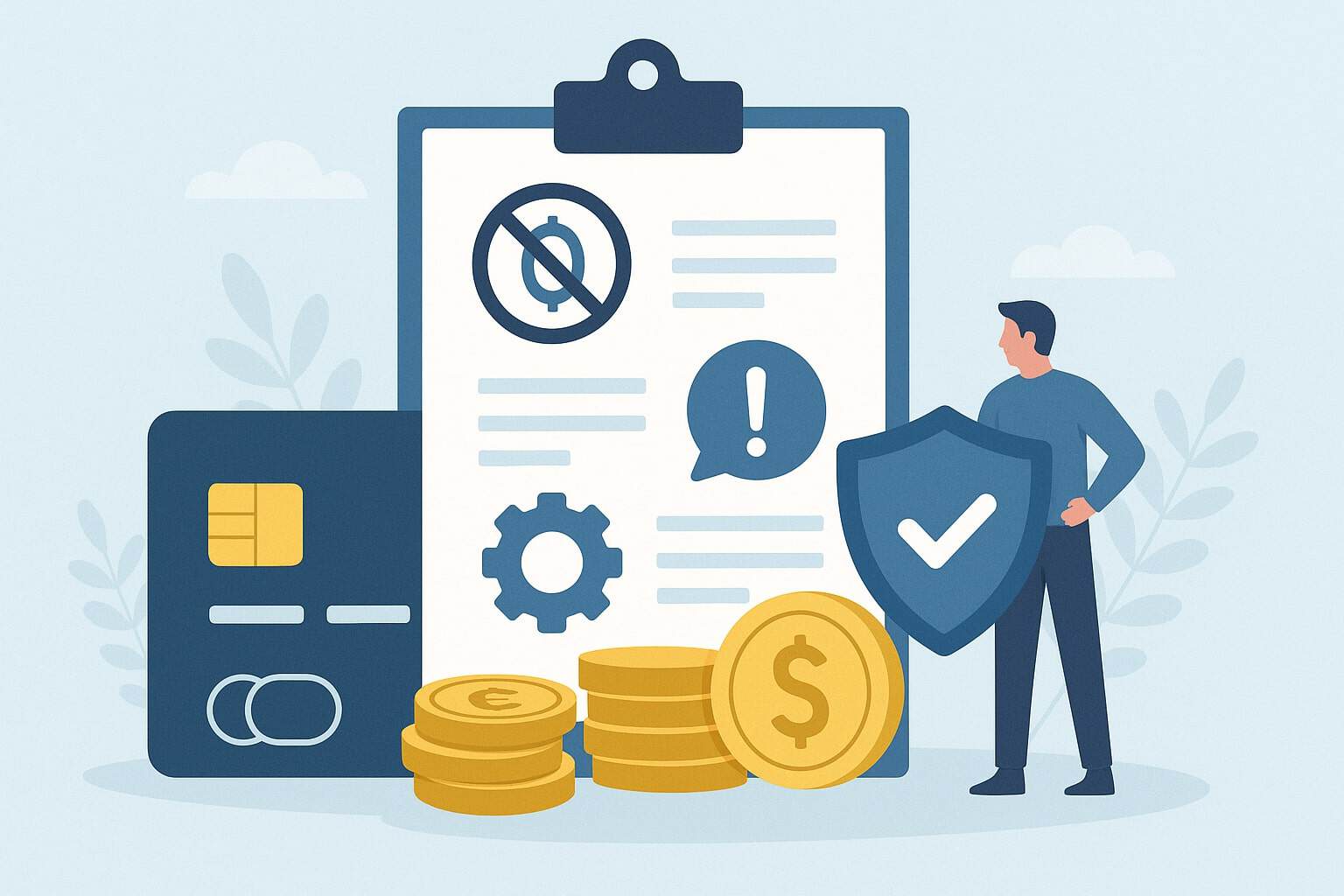
By alphacardprocess October 10, 2025
Chargebacks drain revenue, inflate processing costs, and—if unmanaged—can trigger network monitoring programs that pile on extra fees. The good news: you can meaningfully reduce chargebacks and control fees with the right mix of policy, data, tooling, and workflow.
This guide gives you a practical, up-to-date playbook for reducing chargebacks and avoiding fee creep across Visa®, Mastercard®, and other brands. Where rules have changed recently (like Visa’s Compelling Evidence 3.0 and the 2025 Visa Acquirer Monitoring Program updates), you’ll see specific, current guidance so your team can adapt fast.
Why Chargebacks Happen—and How They Create Extra Fees

Chargebacks originate from three broad causes: true third-party fraud (stolen credentials), merchant error (fulfillment, descriptor, refund, or policy gaps), and first-party misuse (a cardholder disputes a legitimate purchase—often called “friendly fraud”).
Each category has distinct prevention and response tactics. Left unmanaged, disputes don’t just reverse revenue; they raise your measured dispute ratios. Elevated ratios can push you into network monitoring programs, where additional fees, remediation plans, and scrutiny apply.
For example, Visa’s evolving monitoring frameworks (VAMP, and its 2025 consolidation of dispute metrics) change how acquirers and merchants are measured and may include more dispute types in the score. That means prevention work directly lowers the risk of extra fees as well as lost sales.
Operationally, remember the cost stack: the original goods/services, marketing acquisition, shipping, customer support, the chargeback fee itself, and potential representation labor. If you’re an SMB, these soft costs add up quickly—industry research projects billions in losses from fraudulent and first-party disputes alone in 2025.
Treat dispute management as a margin program, not just a compliance chore. Align finance, ops, CX, and fraud teams around a single dashboard and a shared target for dispute rate and win-rate.
The “Newest Rules” You Need to Know in 2024–2025
Two recent rule areas matter most to everyday merchants:
- Visa Compelling Evidence 3.0 (CE 3.0). Effective since April 2023 and still central in 2025, CE 3.0 lets merchants auto-remedy certain first-party fraud disputes (Reason Code 10.4 for card-not-present) by supplying specific, standardized historical purchase data.
If you can show the same cardholder made prior, non-fraudulent transactions that match keyed data (e.g., device/IP, email, address, phone), disputes can be deflected earlier in the flow—often without full representation cycles. Build a habit of storing those data points so they’re instantly retrievable. - Visa Acquirer Monitoring Program (VAMP) 2024–2025 changes. Visa announced that VAMP became effective April 1, 2025, consolidating how dispute performance is tracked.
Updates in March–May 2025 clarified timing and calculations, including the inclusion of some disputes resolved through Rapid Dispute Resolution (RDR) and similar channels.
Expect acquirer-level and merchant-level scrutiny to tighten and plan your thresholds accordingly. If your acquirer shares forward-looking projections, use them to simulate impact and set monthly prevention targets.
Mastercard, meanwhile, continues to focus on first-party misuse with network-level analytics and programs (such as First-Party Trust) that help distinguish true fraud from cardholder disputes of legitimate purchases.
Merchants that feed better transaction context can both prevent friendly-fraud chargebacks and improve their win-rates when disputes do occur. Keep an eye on the latest Mastercard Chargeback Guide (updated May 2025) for reason-code handling and evidence standards.
Build a Data Foundation That Powers Prevention (and CE 3.0 Wins)

Start by capturing the data elements that help both prevent and deflect chargebacks:
- Identity & device context: email, phone, billing and shipping addresses, device ID/fingerprint, IP/geolocation, and account history.
- Behavioral context: prior successful orders (dates, SKUs, amounts), login/authentication logs, delivery confirmation or usage telemetry for digital goods.
- Checkout metadata: AVS/CVV results, 3DS results (version, ECI, authentication value), risk engine scores, and any SCA exemptions or step-ups.
Visa CE 3.0 specifically rewards merchants who can reference two prior, non-fraudulent transactions from the same cardholder within a defined date window and with matching data points.
If your OMS or PSP doesn’t expose this easily, work with your acquirer or gateway to tag and index these fields so your team can auto-attach them during disputes. The same dataset is useful for Mastercard’s first-party misuse patterns and broader network collaboration tools.
Checkout Controls That Reduce Fraud Without Killing Conversion

Modern authentication and risk signals can reduce third-party fraud and also change liability dynamics:
- 3-D Secure (EMV 3DS 2.2). When properly deployed, 3DS can shift fraud liability to the issuer and improve authorization certainty, especially in regulated regions using SCA.
Implement frictionless flows for low-risk transactions and step-up for higher-risk attempts. Keep your gateway configured for 3DS 2.2 support, pass rich device and account data, and monitor fallback rates from 2.x to 1.0. - AVS/CVV with smart rules. Decline mismatches for high-risk baskets; allow mild variances for low-risk returning customers and low-ticket orders.
- Network tokenization. Tokenized credentials reduce compromised-card risk and keep approvals high when cards are reissued.
- Velocity rules and negative lists. Throttle repeat attempts across devices, emails, and BIN-ranges known for risk.
Calibrate so your false-positive rate stays low. Test by segment (first-time buyer vs. returning, domestic vs. cross-border) and watch approval rates and dispute rates together. The aim is to block bad orders early while preserving good revenue—and to create stronger evidence if a dispute proceeds.
Product, Policy, and CX Fixes That Eliminate “Merchant-Error” Chargebacks
Many disputes aren’t fraud; they’re expectations gone wrong. Fix the root and your dispute ratio falls:
- Clear descriptors. Use a recognizable statement descriptor and “soft” descriptor text that includes brand/URL or phone. Confusing descriptors are a classic trigger for “I don’t recognize this charge.”
- Shipping and fulfillment hygiene. Provide tracking, signature on high-value shipments, and photo confirmation on delivery where appropriate. For digital goods, confirm account activity logs and IP/device continuity around the time of use.
- Refund & cancellation clarity. Prominently state timelines, restocking fees (if any), and return windows. Automate confirmation emails for cancellations and refunds so customers don’t escalate to their bank.
- Subscription transparency. Send renewal reminders, make cancellation self-service, and provide proration rules. Good subscription UX dramatically lowers “charge not recognized” and “merchandise not received” disputes.
Tie these policies to your representation playbook: every promise you make publicly should have a corresponding piece of evidence you can capture and submit if needed. This alignment often lifts win-rates more than fancy tools.
Friendly Fraud (First-Party Misuse) Playbook in the CE 3.0 Era
First-party misuse is surging across ecommerce, with large portions of disputes coming from legitimate cardholders reversing charges. Your best defense is a blend of pre-transaction clarity, post-transaction transparency, and dispute-time data:
- Pre-transaction: plainly state what the buyer gets, when, and how to get help. Offer instant self-service (portal or chatbot) to resolve “where is my order?” before it becomes a dispute.
- Post-transaction: send detailed receipts showing itemized purchases, delivery status, recognized descriptor, and how to contact you. If the purchase is part of a recurring plan, include the plan name, next-bill date, and cancellation link.
- Dispute-time: leverage CE 3.0 by auto-checking whether two prior, non-fraudulent transactions match core identifiers. Feed Order Insight/issuer inquiry tools with rich order context to preempt escalation.
Where available, participate in acquirer/network collaboration (e.g., RDR-style programs) that can stop a dispute before it counts against ratios or fees.
Mastercard’s analytics-driven approach similarly rewards merchants who provide richer transaction context. The takeaway: save everything (safely and compliantly) and make it retrievable within seconds.
How to Avoid Extra Fees Tied to Dispute Ratios
To keep clear of network monitoring programs and their fees:
- Know your denominator. Track dispute ratio exactly as your acquirer/network calculates it (Visa’s VAMP changes unify metrics; some RDR/CDRN resolutions may still be included). Build internal dashboards to mirror these formulas so there are no surprises.
- Set monthly guardrails. Establish a “yellow zone” well below thresholds and trigger escalation (manual review, more 3DS) when you cross it.
- Use collaboration/deflection. Participate in issuer inquiry programs that resolve issues earlier so fewer cases mature into chargebacks that hit your metrics.
- Segment by brand and MID. If you operate multiple MIDs or regions, isolate hot spots and fix them first before they pull the whole portfolio into a fee program.
- Document remediation. If you do enter a program, show your acquirer a clear prevention plan (policy changes, tooling, staffing) and request periodic reviews to exit as soon as performance stabilizes.
Issuers and networks are targeting first-party misuse in 2025 with AI and data sharing; the direction is clear. Merchants who align with these tools and evidence frameworks tend to keep ratios—and therefore fees—down.
Representment That Actually Wins (Without Burning Hours)
When a dispute does land, make your evidence package airtight and relevant to the reason code:
- Map evidence to reason code. For “fraud—CNP,” emphasize 3DS results, device/IP matches, prior successful orders (CE 3.0), delivery confirmation or usage logs, and communication history.
For “merchandise not received,” focus on carrier scans, signatures/photos, and customer support transcripts. - Be concise but complete. Issuer back-office teams spend seconds per case. Use labeled exhibits, bullets, and timestamps that make the conclusion obvious.
- Submit on time and through the right channel. Follow your acquirer’s process in Mastercom (Mastercard) or VROL (Visa) and mind each brand’s windows. The latest Mastercard Chargeback Guide (May 2025) is the definitive reference for Mastercard disputes.
Track win-rate by reason code, and learn. If you rarely win a certain reason code, fix upstream causes (descriptor confusion, subscription UX, fulfillment lag) instead of wasting cycles on low-odds fights.
Tech Stack: Tools That Reduce Chargebacks and Fees
- Gateway with EMV 3DS 2.2 and dynamic risk rules (supports frictionless + step-up, passes rich data).
- Order-insight and collaboration tools (e.g., issuer inquiry, Rapid Dispute Resolution-style workflows) to resolve misunderstandings before formal chargebacks.
- Fraud monitoring with device intelligence and behavioral biometrics to spot botting and mule patterns.
- Chargeback management platform integrated with your OMS to auto-assemble evidence (CE 3.0 packages) and submit via VROL/Mastercom.
- Analytics that mirror network ratios so finance can forecast fee exposure under VAMP and similar programs.
Team Process: The Five-Step Weekly Rhythm
- Review KPIs: dispute rate (by brand/MID), top reason codes, win-rates, and fee exposure projections.
- Root-cause huddles: pick the top two drivers (e.g., “not received” from one warehouse; “not recognized” on one descriptor) and assign owners.
- Backlog & experiments: update copy, descriptors, checkout prompts, and 3DS routing rules.
- Case QA: sample a few closed disputes for evidence quality; refine templates.
- Exec summary: circulate a one-pager with actions, owners, and expected impact on ratios/fees.
This cadence keeps prevention and fees in check while improving your representation success over time.
Industry-Specific Tips to Reduce Chargebacks and Avoid Extra Fees
- Subscriptions/SaaS: send renewal reminders, allow one-click cancel, and surface next bill date inside the app. Provide post-purchase usage logs tied to device/account.
- High-ticket retail: require signature or photo-on-delivery; consider ID verification at pickup; keep serial numbers and warranty registrations as evidence.
- Digital goods & gaming: log session starts, IP/device, content unlocks, achievement timestamps, and ban-appeal transcripts.
- Marketplaces: enforce seller SLAs, payout holds for risky sellers, and buyer messaging that resolves disputes in-platform first.
- Travel & events: reiterate non-refundable terms at purchase and in itineraries; capture check-in or ticket-scan events.
Across all verticals, tie your evidence collection to CE 3.0 criteria and issuer collaboration so you’re preventing fee-counting disputes before they start.
Metrics That Matter (and How to Read Them)
- Dispute Ratio (by network definition). Track the exact inputs used by Visa/Mastercard, not just internal counts. With VAMP’s 2025 changes, ensure your numerator and denominator match the new guidance—including which resolved disputes are still counted.
- Win-Rate by Reason Code. Use it to prioritize policy fixes; 10-point improvements here often beat chasing marginal fraud declines.
- Pre-chargeback Deflection Rate. Measures how many issuer inquiries or collaboration cases you resolve before they mature.
- 3DS Success & Friction Rates. Keep friction low while preserving liability shift on risky segments.
- Approval Rate & False-Positive Rate. Optimize together; blocking too aggressively can hurt lifetime value more than disputes do.
Governance, Recordkeeping, and Training
Treat dispute management as controlled, repeatable operations:
- Policies: a written playbook for accept/decline rules, 3DS use, evidence templates, and refund standards.
- Records: retain order, delivery, and authentication data for at least the full dispute window for your products.
- Access: centralize in a secure repository; restrict PII access to trained staff.
- Training: quarterly training on new network rules (e.g., CE 3.0 nuances, Mastercard’s latest guidance). The 2025 Mastercard Chargeback Guide is a useful training anchor for Mastercard workflows.
Putting It All Together: A 90-Day Action Plan
Days 1–30 (Stabilize):
- Enable/optimize 3DS 2.2 and pass rich data.
- Fix descriptors; publish refund/cancel policies prominently; add renewal reminders for recurring products.
- Start capturing CE 3.0-relevant data elements and index prior order matches.
Days 31–60 (Deflect & Prove):
- Integrate issuer collaboration (Order Insight/RDR-style tools).
- Build auto-assemble packs for common reason codes; QA five random cases per week.
- Launch CX prompts that deflect “where’s my order?” to self-service.
Days 61–90 (Optimize & Forecast):
- Mirror VAMP/VROL/Mastercom metrics in your BI; simulate thresholds for Q3–Q4.
- Segment risky SKUs/regions; tune rules; A/B step-up triggers.
- Create an executive dashboard showing dispute trend, win-rate, and fee exposure under 2025 rules.
FAQs
Q.1: What is the single most effective step for reducing chargebacks without crushing conversion?
Answer: Adopt 3DS 2.2 with adaptive routing and pair it with clear descriptors and renewal reminders. In most verticals this combination cuts fraud and “not recognized” disputes with minimal friction—and in many cases shifts fraud liability away from you.
Ensure your gateway supports EMV 3DS 2.2 and passes enhanced data elements to maximize frictionless approvals.
Q.2: How does Visa Compelling Evidence 3.0 change my evidence strategy?
Answer: CE 3.0 rewards structured, historical data. If a cardholder claims fraud (10.4) but you can show two prior, non-fraudulent transactions within the defined window, with matching identifiers, you can often auto-deflect the dispute earlier—saving time, protecting your ratio, and avoiding extra fees. Build data capture and retrieval around those specific fields.
Q.3: I’m worried about landing in a monitoring program. What should I do first?
Answer: Ask your acquirer for your current and projected dispute ratio under 2025 calculations, including any changes from VAMP and what disputes count post-resolution.
Set monthly guardrails 25–40% below thresholds and create an escalation plan (e.g., more 3DS on first-time buyers, signature on high-value shipments) when you cross them.
Q.4: Is friendly fraud really getting worse?
Answer: Yes. Multiple analyses indicate first-party misuse is a growing share of total disputes in 2025. Networks are responding with analytics programs and evidence standards that favor merchants who provide richer context.
That’s why storing device, account, and prior-purchase data—and exposing it through issuer collaboration tools—pays off.
Q.5: What about subscriptions—how do I avoid “I forgot to cancel” chargebacks?
Answer: Send renewal reminders, make cancellation frictionless, and show the next bill date in-app. Pair these with detailed receipts and a help path that’s faster than contacting the bank. These steps dramatically reduce “not recognized” and “cancelled” disputes—and the downstream fees they cause.
Conclusion
Reducing chargebacks and avoiding extra fees is a system—not a single button. You’ll win by combining (1) modern authentication and risk controls (3DS 2.2, device intelligence), (2) crystal-clear policies and customer communications, (3) bulletproof data capture aligned to CE 3.0, and (4) a steady, cross-functional operating rhythm.
Keep your metrics aligned to how the networks score you—especially with 2025 VAMP changes—and use issuer collaboration to deflect disputes before they count. Do this well and you’ll lower loss, lift authorization rates, and stay far from fee-triggering thresholds—while giving your legitimate customers a smoother experience.